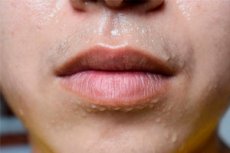Nye publikasjoner
Innovativ svetteanalyseenhet muliggjør ikke-invasiv helseovervåking
Sist anmeldt: 02.07.2025

Alt iLive-innhold blir gjennomgått med medisin eller faktisk kontrollert for å sikre så mye faktuell nøyaktighet som mulig.
Vi har strenge retningslinjer for innkjøp og kun kobling til anerkjente medieområder, akademiske forskningsinstitusjoner og, når det er mulig, medisinsk peer-evaluerte studier. Merk at tallene i parenteser ([1], [2], etc.) er klikkbare koblinger til disse studiene.
Hvis du føler at noe av innholdet vårt er unøyaktig, utdatert eller ellers tvilsomt, velg det og trykk Ctrl + Enter.

Forskere fra Korea Advanced Institute of Science and Technology (KIST) har sammen med professor John A. Rogers fra Northwestern University annonsert at de har utviklet en svettemålingsenhet som ikke krever fysisk aktivitet, men stimulerer svetting ved å levere medisiner gjennom huden. I motsetning til tidligere metoder som krevde fysisk trening for å indusere svetting, leverer denne enheten svettekjertlstimulerende medisiner direkte gjennom huden.
Svette inneholder biomarkører som kan spore en rekke helsetilstander, fra diabetes til genetiske lidelser. Svetteinnsamling, i motsetning til blodprøvetaking, foretrekkes av brukere fordi det er smertefritt. Tidligere krevde imidlertid intens fysisk aktivitet å få i seg nok næringsstoffer eller hormoner fra svette, noe som skapte problemer for personer med begrenset mobilitet.
Utvikling av enheten Forskerteamet utviklet en fleksibel enhet som kan levere legemidler til svettekjertler ved å påføre strøm til en hydrogel som inneholder medisinene. Enheten, som er liten og myk, kan enkelt festes til huden. Svette indusert av medisinen samles opp i mikrofluidiske kanaler i enheten og analyseres for biomarkører ved hjelp av biosensorer. Dette muliggjør analyse av biomarkører i svette, noe som reduserer behovet for tidkrevende sykehusbesøk for testing og reduserer risikoen for biomarkørkontaminering under testing, noe som forbedrer nøyaktigheten.
Apparatet som ble utviklet av forskerteamet ble festet til spedbarn med cystisk fibrose, og konsentrasjonen av klorid, en biomarkør i svette, ble bekreftet. Resultatene var sammenlignbare med de som ble oppnådd ved tradisjonelle metoder for å analysere svette samlet på sykehus, med en nøyaktighet på over 98 %. Apparatets stabilitet på huden ble også bekreftet ved å måle hudtemperatur og pH-verdier. Siden cystisk fibrose hovedsakelig manifesterer seg i spedbarnsalderen, er kontinuerlig overvåking av sykdomsprogresjon og fysisk tilstand nødvendig. Med dette apparatet kan overvåking enkelt utføres hjemme, noe som reduserer psykologisk og fysisk stress for barn og deres omsorgspersoner.
Den nye enheten bidrar til å utvide ikke-invasive teknologier for sykdomsovervåking basert på svette hos friske voksne. I tillegg kan transdermal legemiddelleveringsteknologi ikke bare brukes til å indusere svette, men også til å øke hastigheten på legemiddelleveringen til lokaliserte områder som hudsykdommer eller sår, noe som akselererer helbredelsen.
Dr. Kim Ju-hee fra KISTs Bionic Research Center sa: «Gjennom to års felles forskning med Northwestern University har vi ikke bare løst problemene med eksisterende metoder for svetteinduksjon, men også oppnådd suksess i kliniske studier, noe som bringer oss ett skritt nærmere kommersialisering.»
Professor John A. Rogers la til: «Vi planlegger å gjennomføre storskala kliniske studier og kommersialisering, inkludert på voksne, i fremtiden.»
Denne forskningen ble utført under KIST Major Projects og Outstanding Young Researcher Program (RS-2023-00211342) støttet av Vitenskaps- og IKT-departementet (minister Lee Jong-ho). Forskningsresultatene ble nylig publisert på nett i den siste utgaven av det internasjonale tidsskriftet «Biosensors & Bioelectronics» (IF 12.6).
Resultatene av studien ble publisert i tidsskriftet ScienceDirect.
